Research papers
← vista completaPublished on November 17, 2021 | http://doi.org/10.5867/medwave.2021.10.8486
Use of public transport associated with colds in the capital of Peru: A cross-sectional study
Uso del transporte público asociado al padecimiento de resfríos en la capital del Perú: un estudio transversal
Abstract
Introduction Confined and crowded environments, such as public transport, can act as hot spots for spreading infectious diseases. Of these, common acute respiratory infections of easy contagion are of great interest.
Objectives To establish the association between the use of ground public transport and the acquisition of common cold in Lima, Peru.
Methods Analytical cross-sectional study. It was carried out through secondary data analysis from a primary study conducted at the Faculty of Medicine of the Ricardo Palma University in Lima, Peru. The dependent variable was the acquisition of common colds, and the independent variable was the use of public transportation (bus, metropolitan, bus corridor, collective cab, non-collective cab, and other means). The covariates of interests were age, sex, and socioeconomic level time and frequency of exposure. Generalized linear models were performed to estimate prevalence ratios (PR), using the Poisson family, log link and robust models.
Results Of the 591 respondents, 53% were female, the median age was 20 years, and 90.3% belonged to the middle class. Most traveled by bus (72.4%), and in the last three months the median number of colds was one. We found a difference in the number of colds according to the age of the respondents (P = 0.019). Having a common cold was associated with traveling more days per week in public transport (adjusted prevalence ratio: 1.04; 95% confidence interval: 1.03 to 1.05; p value < 0.001), spending more minutes per day traveling to work (1.0025; 1.0023 to 1.0027; p value < 0.001), more minutes per day returning home (1.0022; 1.0015 to 1.0030; p value < 0.001), more use of the subway or metro (1.37; 1.29 to 1.46; p value < 0.001), or using the municipal bus corridor (1.22; 1.01 to 1.47; p value = 0.036).
Conclusions The use of public ground transportation is associated with the acquisition of the common cold. Confined spaces and poor ventilation are essential factors to consider.
|
Main messages
|
Introduction
Acute respiratory infections involve a variety of etiologic agents and manifest a wide range of upper and lower respiratory tract symptoms. The common cold is one of the most common upper respiratory tract infections, which typically presents with nasal congestion, rhinorrhea, tearing, sneezing, coughing, low-grade fever, and sore throat. Although mild, these symptoms continue to be a major economic and social burden [1].
People visit confined and crowded environments in their daily lives (e.g., city squares, business districts, transportation hubs) that can act as hot spots for spreading infectious disease [2]. Traveling involves contact with many people, so vehicle transportation is constantly the site or even the source of outbreaks [3],[4].
Even though public ground transportation is a major source of infection during epidemics and pandemics, the association between frequent use of this type of transportation and the acquisition of acute respiratory infection is not well understood. On the other hand, the role of aircraft and ships in the spread of airborne diseases is well documented [2],[5],[6],[7],[8].
The lack of certainty about disease transmission within ground public transport and logistical obstacles related to contact tracing may be the main reasons for the limited number of relevant publications related to this topic. Transmission of airborne infectious diseases in-ground public transport is presumed to occur but translates only in unpublished reports. Consequently, the risk of infectious disease transmission and the public health effect of airborne transmission of communicable diseases during everyday traveling remains largely unknown [9].
In Peru, land public transport is made up of an electric train line, a metropolitan bus system, and urban public transport vehicles consisting of small-sized rural vans (also called "combis"), minibuses, and omnibuses [10]. Therefore, the present research aims to establish the association between public land transport and common cold in Lima, Peru. This information may provide an opportunity to implement preventive actions in public ground transportation and thus reduce the risk of contagion.
Method
Study design and setting
This is an analytical cross-sectional study with data collected during October 2019. A secondary analysis was conducted, with prior authorization from the research group, of a study that determined the association of psychopathological factors and time spent on public ground transportation in users of Lima, Peru. The database was assembled as part of the Research Theory and Methodology course of the Faculty of Medicine of Ricardo Palma University. The measurement of the response variables was given through a validated instrument: the Depression, Anxiety and Stress Scale (DASS - 21). The rest of the variables (hours spent daily in public transportation, sex, age, level of academic studies, and means of transportation commonly used) were added to the survey. The data were subsequently corroborated by transferring them to Excel. The primary research group supervised the generation and quality control of the data within an official academic course. Before data analysis, the responses were coded, and a double-check was performed on each participant.
Population and sample
The initial population consisted of 600 public ground transportation users of Lima, Peru. Since the sample was taken from the most known or accessible places where the greatest number of public transport users are found, a non-probabilistic snowball sampling was carried out
All who agreed to answer the questionnaire voluntarily were included, and the content was validated by expert judgment in the primary publication. Nine minors were excluded (excluding less than 2%), giving a final sample of 591 public transport users. The individuals included were those who had the study variables of interest in the database. The dependent variable was the common cold (taken according to the survey as the number of times the person has had a cold in the last three months).
The independent variable was public transportation (taken as the means that the person most frequently uses to travel from one place to another), which included: the bus, the "colectivo" (private cars that informally transport people), the subway (either electric or metropolitan train), the corridor (mass transit buses that travel through an exclusive corridor) or by cab. Other variables included age (in years), sex (male or female), socioeconomic level (perception of the respondent as belonging to the lower class/poor, middle class, or upper class/wealthy), exposure time (hours and minutes that a person takes from the time he/she leaves home to the time he/she arrives at work, hours and minutes that a person takes from the time he/she leaves work to the time he/she arrives home, and hours a person is on public transportation per day), and frequency of exposure (days per week a person commutes to and from work).
Statistical analysis
Stata statistical software version 11.1 (Stata Corp, Texas, United States) was used for data processing. A multivariate logistic regression model was applied to the associated variables. Categorical variables were described by frequency distribution and percentages, and quantitative variables were described by measures of central tendency and measures of dispersion. Four tables were used for the analytical statistics. In the first table, the socio-educational variables and the time spent using public transport were crossed with common colds. In the second table, the crossover of transport according to the number of colds was carried out using the Chi-square test. In the third table, bivariate analysis of the number of colds according to the number and type of transport used was performed. We obtained the adjusted coefficients, 95% confidence intervals, and p values through the generalized linear models (Poisson family, log link function, adjustment for robust variances, and socioeconomic class). A multivariate analysis was performed for the final table to obtain the adjusted prevalence ratios, their 95% confidence intervals, and p values. The generalized linear models (Poisson family, log link, and robust models) were also used in the analysis.
Ethics
Authorization was obtained from the primary research group. Only individuals who consented to participate in the study were considered while respecting the confidentiality of the information. The Ethics Committee of the Universidad Privada Antenor Orrego approved the present study.
Results
Of the 591 respondents, the mean number of hours spent in transport per day was 2.15 hours (standard deviation 1.26 hours). The median number of days per week spent in public transport was six (interquartile range five to six days). The median age was 20 years (interquartile range 18 to 25 years), 90.3% belonged to the middle class, and the median number of colds in the last three months was one (interquartile range: one to two colds). Most traveled by bus (72.4%), followed by subway or metro (9.3%), cab (8.5%), corridor (4.8%), and "colectivo" (3.4%) (Table 1).
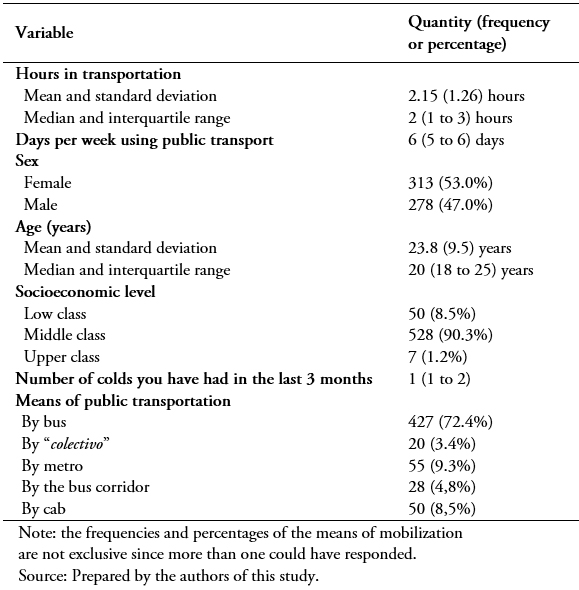 Full size
Full size Table 2 shows no difference in the number of colds according to sex, socioeconomic level, the number of days per week that they used public transport, or the number of minutes they took to get to work or go back home. On the other hand, there was a statistically significant difference in the number of colds according to age (P = 0.019).
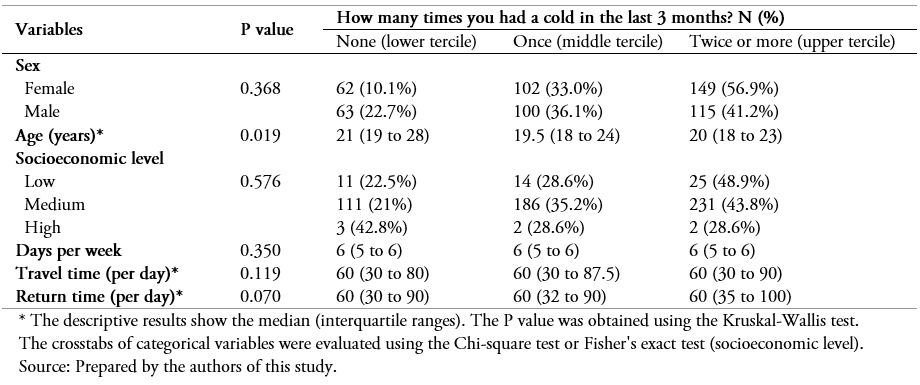 Full size
Full size In Table 3 we observed only a significant association between the number of colds and greater use of the public bus (46.3% if they used it compared with 38.2% of those who did not use it among participants who had two or more colds, P value = 0.048) and of the collective cab (20.0% if they used it versus 45.0% of those who did not use among participants who had two or more colds, P value = 0.043).
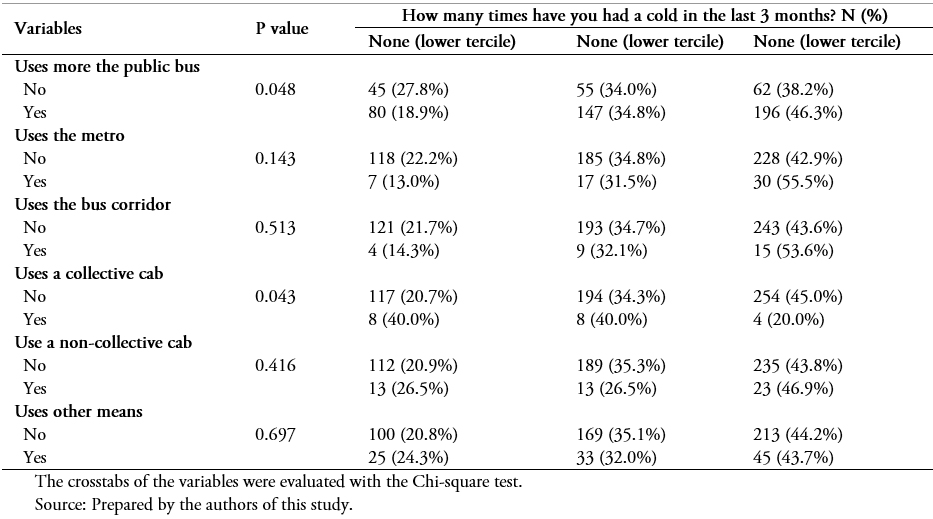 Full size
Full size In a bivariate analysis, it was found that a greater number of days per week using public transportation, more minutes per day going to work, more minutes per day returning home, the predominant use of the metro or the municipal bus corridor were associated with a higher incidence of colds. In contrast, the use of collective cabs was associated with a lower incidence of colds (Table 4).
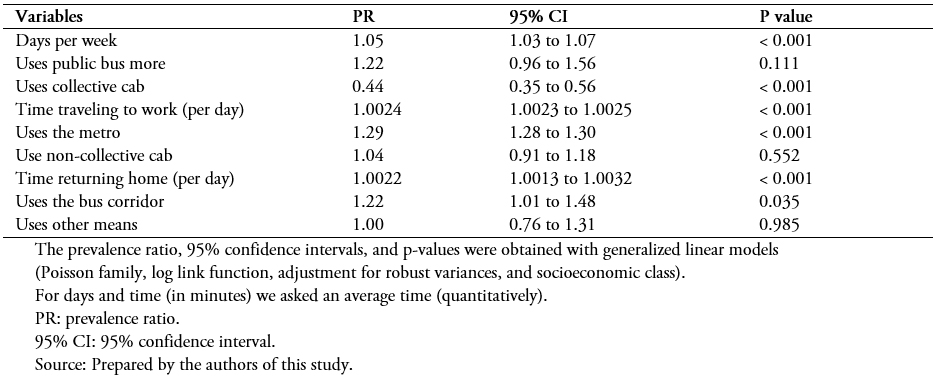 Full size
Full size Through multivariate analysis, we found that a greater number of days per week using public transport, more minutes per day going to work, more minutes per day returning home, more use of the metro or the municipal bus corridor were associated with a higher incidence of colds. On the other hand, using a collective cab was associated with a lower incidence of colds; all these crosstabs were adjusted for sex, age, and socioeconomic level (Table 5).
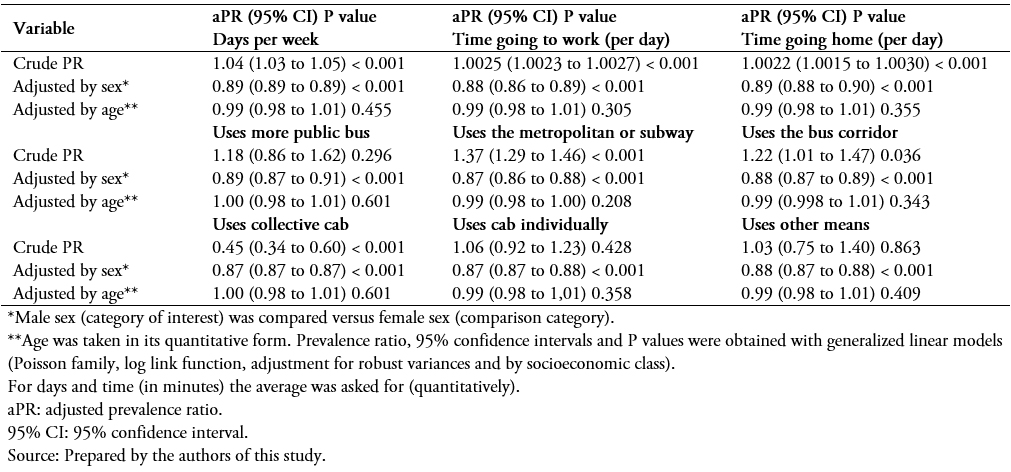 Full size
Full size Discussion
We found that more days per week and minutes per day of the round trip traveling on public transport were associated with a higher incidence of common colds. According to the type of transport used, a greater acquisition of colds was reported using the metro or the municipal bus corridor. Furthermore, we found no difference in the number of colds according to sex (P = 0.368) or socioeconomic level (P = 0.576). However, there was a difference in the number of colds according to the age of the respondents (p = 0.019).
Similarly, Fuqiang Cui et al. study on the transmission of influenza A (H1N1) in 2009 [11] found that attack rates increased with exposure time, in addition to close contact on a train. The literature mentions that the frequent recurrence of the common cold is because of its multiple etiologies, each with specific viral antigenic types, or because the antibody response generated after infection by a respiratory virus is often not fully protective, even after re-exposure with the same serotype [12]. Our results contradict the hypothesis stating that acquiring partial immunity against various respiratory viruses increases with its exposure.
Joy Troko et al. [13] found a statistically significant association between acute respiratory infections and bus or streetcar use within five days before symptoms onset. They also detected an increased risk among occasional users, although this trend was not statistically significant. The common cold may spread predominantly by large droplet transmission, so the exposure time and the number of passengers on the most commonly used public transport modalities with an enclosed environment (such as the subway or bus) may increase the risk of transmission of airborne infections [14].
Initial community and family studies reported a higher frequency of respiratory infections in females than males, probably due to a higher exposure of women to children [15]. A low socioeconomic status may be associated with an increased risk of developing a common cold and other comorbidities in general [16]. The incidence of common colds usually decreases with age reaching approximately two episodes per year in adults. However, it is higher in adults with occupational or household exposure to children between early fall and late spring [17]. Considering that the latter two variables could not initially be measured in our study, and the fact that our population is predominantly composed of young adults warrant that these findings should be taken with caution.
A similar study conducted in metropolitan Lima by Yumpo Cárdenas and collaborators [18] found an association between influenza syndrome and the use of public transport. Lara Goscé and Anders Johansson [19] suggested a link between the use of public transport and the transmission of infectious diseases following a study on the London Underground, where large crowds of people spent considerable time on the train and came into contact with a large number of people. These results underpin the importance of the influence of poor ventilation, person-to-person proximity (exposure), and the confined environment acting as a "hot spot" for spreading disease. Even more so, with the informality of most third-world country buses [2],[10],[20]. Studies have shown that the flow lines from an infected person to the escape door are limited, and people in the vicinity of the infected person are exposed and at risk of being infected [10],[20]. As a result of this challenge, prevention strategies are already in place within public transport for some significant impact respiratory diseases [21],[22].
There is a possibility that transmission may have occurred between passengers and their possible proximity to each other. The length and frequency of travel may have increased the likelihood of cold transmission. However, other possible causes cannot be ruled out, as some passengers may have contracted the infection before or after using the transport.
The main limitations of our study are due to the nature of the methodology and design. Although the main variables were analyzed, our study's retrospective nature did not permit the inclusion of all the intervening variables (climatic season, cohabitation with other family members or children, and presence of other comorbidities). Moreover, due to the temporal ambiguity between exposure and disease inherent in a cross-sectional design, we cannot determine a cause-effect interaction. Other aspects to be taken into account are the pre-existing limitations of the primary study. Among other limitations linked to the type of subject selection, it is necessary to consider that a non-probabilistic selection by convenience was made and that there could be a bias by not including different types of public transport users. On the other hand, the cold variable was obtained through self-diagnosis and not through a physician's assessment, which would be more appropriate. However, it has been reported that due to people's familiarity with the common cold and the variability in symptomatology, it seems more reasonable to use self-diagnosis [23].
Conclusion
Despite its limitations, this study found an association between the use of public ground transportation and the acquisition of the common cold.
Individuals who commuted more days per week, spent more minutes per day on the outward and return trips within public transportation, and used more the metropolitan and the municipal bus corridor were associated with a higher incidence of colds.
These findings underpin the role of confined and poorly ventilated spaces in the transmission of respiratory illnesses and should be taken into account to reduce public transport contagion.
In addition, multicenter and prospective studies with a larger population should be carried out to corroborate this study's results and obtain a higher quality of evidence.
Notes
Contributor roles
LSSS: conceptualization, drafting, and preparation of the original and final manuscript. CRM: conceptualization, drafting of the project, data collection, and analysis, drafting and approval of the final manuscript.
Competing interests
The authors completed the ICMJE conflict of interest statement and declared that they received no funding for the completion of this article; have no financial relationships with organizations that may have an interest in the published article in the last three years; and have no other relationships or activities that may influence the publication of the article. Forms can be requested by contacting the responsible author or the Editorial Committee of the Journal.
Funding
The authors declare that they did not receive funding for this work.
Ethics
The present study has the approval of the Ethics Committee of the Universidad Privada Antenor Orrego with resolution N°0374 - 2020.
Language of submission
Spanish.

